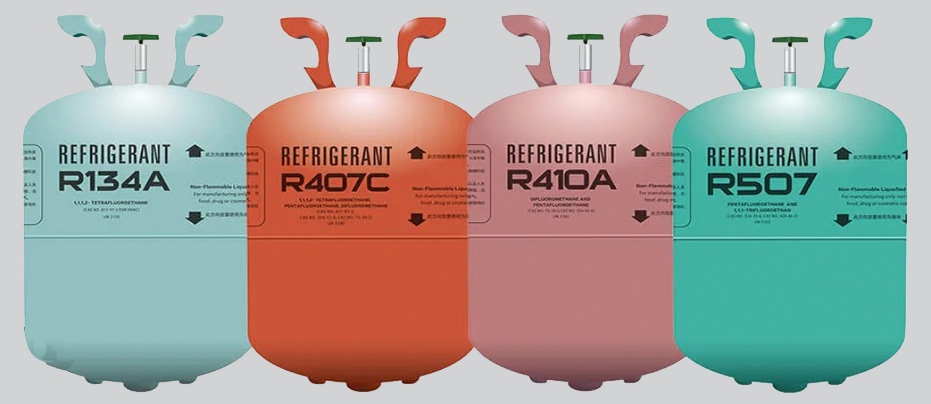
One of the hottest topics in the HVAC/R industry today is the upcoming change in refrigerants, due to the mandated elimination of many of the common refrigerants in use today.
These refrigerants, which are HFC (hydrofluorocarbon) gases, are being targeted due to their high “global warming potential” (GWP).
As a manufacturer of refrigerant coils, Marlo is at the forefront of this industry transition. Our engineering team is well prepared to continue to deliver high-quality, reliable refrigerant coils that use any of the wide range of available alternative refrigerants, in order to assure our coils and air handling units comply with all new regulations.
How we got here
The American Innovation and Manufacturing (AIM) Act, enacted by Congress on December 27, 2020, authorized the U.S Environmental Protection Agency (EPA) to phase down the production and importation of HFCs, which are greenhouse gasses with high GWP, according to the EPA. The majority of common refrigerants in use today, such as R-134a, R-410A, R-404A and many others, are all HFCs.
In response to the AIM Act, the EPA issued a final rule on October 5, 2023, which calls for the elimination of HFC refrigerants in most new air conditioning and refrigeration systems beginning January 1, 2025. As the HVAC/R industry transitions away from HFCs, many of the refrigerants replacing them will have higher pressure ratings, incompatibility with certain materials, and/or increased levels of flammability, creating new challenges for both coil manufacturers and end users.
The good news is, Marlo has been through refrigerant transitions in the past, and has always been able to reengineer our coils to simultaneously meet our customers’ needs and comply with changing regulations. While disruptive to the industry, the current phaseout of HFCs is really no different than the phaseout of CFCs (chlorofluorocarbons), such as R-11 and R-12, in the 1980s, and the phaseout of HCFCs (hydrochlorofluorocarbons), such as R-22, starting in the late 1990s.
Coils customized for each refrigerant
We often talk about the fact that every coil and AHU we manufacture is custom designed and built for a particular application (nothing “off the shelf”). That’s why we are well positioned to easily navigate the changing refrigerant landscape. We already engineer coils for a range of industries, applications and objectives, using a wide variety of metals to meet specific needs.
As a result, it is standard operating procedure for us to design refrigerant coils to meet the unique demands of each new refrigerant. For example, the use of CO2 as a refrigerant (R-744) is growing in popularity due to its minimal GWP, as well as its zero ozone depletion potential.
However, CO2 has an extremely high operating pressure of up to 1,000 psi or more, requiring coil tubing made of copper-iron or stainless steel, which are much more difficult to join than standard copper tube. But at Marlo, we already manufacture coils – particularly industrial process coils for extreme environments – with these materials on a regular basis. So this won’t even be a change for our engineers or factory workers.
Another good example of a special refrigerant requirement is with ammonia – which also has no impact on the ozone or on global warming. Ammonia is incompatible with copper, making steel, stainless steel and aluminum tubing common choices for coils using this refrigerant. Marlo regularly makes coils with steel and stainless steel tubes, as well as with aluminum tubing. Just ask your Marlo IMR about our many tubing options.
Trust the Marlo engineering team to meet your needs
Marlo engineers are not only experienced in designing coils made with an array of materials, they continuously educate themselves on the characteristics of both new and old “replacement” refrigerants. This knowledge allows them to design refrigerant coils for maximum performance and efficiency, no matter what the cooling medium.
We will take into consideration all aspects of a customer’s application and objectives when helping to choose a refrigerant. Energy efficiency, and the resulting impact on operating costs, will always be a top priority. But safety will also be a factor, since many of the new refrigerants coming into use are mildly flammable (A2Ls), flammable (A2s) or highly flammable (A3s). Toxicity levels, for refrigerants such as ammonia, will also be considered, based on the potential for human exposure.
A final thought: Beware of “one size fits all” coils
With the change in refrigerants, some coil manufacturers are promoting “universal” coils that work with multiple (or even all) refrigerants. While those coils may perform the cooling function, they will rarely provide the best performance and/or efficiency in any given application. So, while they may provide a quick and less expensive solution, they will rarely pay off for the end user in the long run.
If you have concerns about complying with the new refrigerant regulations, just contact your local Marlo representative. We will be more than happy to get our engineering team involved to assure you always get the ideal coil for your needs.
Email Registration
Please complete the form below to sign up for our news alerts and other email communications.
"*" indicates required fields